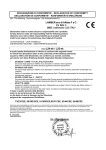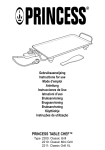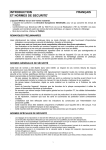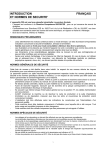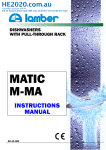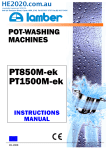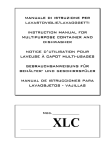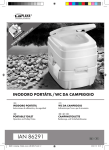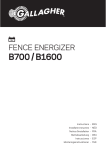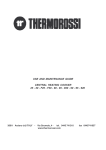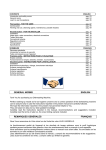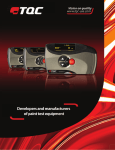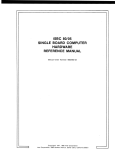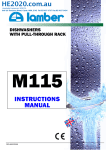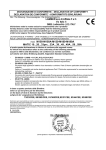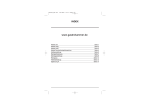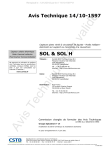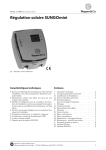Download Product Information Sheet 2
Transcript
HE2020.com.au Hospitality Equipment 2020 P/L Unit 6/6 Tennyson Street, Clyde, NSW, 2142 Tel.02 9637 3737 Fax.02 9637 3434 LAVA-OGGETTI LAVE-BATTERIE WARE WASHER ZUBEHÖRE-SPÜLERE P550-ek P700-ek MANUALE ISTRUZIONI INSTRUCTIONS D'EMPLOI INSTRUCTIONS MANUAL INSTALLATION-BEDIENUNG REV.04/01/2010 HE2020.com.au Unit 6/6 Tennyson Street, Clyde, NSW, 2142 Tel.02 9637 3737 Fax.02 9637 3434 [email protected] DICHIARAZIONE DI CONFORMITA' - DECLARATION OF CONFORMITY Noi - The following - Nous soussignés - Die Unterzeichnete Fa: dichiariamo sotto la nostra esclusiva responsabilità che il prodotto hereby declares under full responsability that the following product attestons sous notre entière responsabilité que le produit suivant erklärt unter eigener Verantwortung, dass folgende Produkte LAVAOGGETTI - LAVE-BATTERIE - WARES-WASHER – ZUBEHÖRE-SPÜLER mod. P550-ek/P700-ek al quale questa dichiarazione si riferisce è conforme alle seguenti norme: for which this declaration refers to the conformity of the following standards: auquel se réfère cette déclaration, est conforme aux normes suivantes: auf welche sich diese Erklärung bezieht, folgendem Standard entsprechen: Sicurezza degli apparecchi elettrici d’uso domestico e similare - Norme generali EN60335-1(2002) + A1/A11(2004) + A12 (2006) + A2 (2006). Safety of household and electrical appliances - General requirements EN60335-1(2002) + A1/A11(2004), A12 (2006) + A2 (2006) Sicurezza degli apparecchi elettrici d’uso domestico e similare - Norme particolari per lavastoviglie per uso collettivo EN60335-2-58 (2005) Safety of household and electrical appliances - Part 2^ Particular requirements for commercial electric dishwashing machines EN60335-2-58 (2005) Apparecchi elettrici per uso domestico e similare – Campi elettromagnetici – Metodi per la valutazione e la misura EN50366 (2003) + A1 (2006) Household and similar electrical appliances – Electromagnetic fields – Methods for evaluation and measurements EN50366(2003) +A1(2006) Limiti e metodi di misura delle caratteristiche di radiodisturbo degli apparecchi elettrodomestici, e similari a motore o termici, degli utensili e degli apparecchi elettrici similari. EN 55014 –1(2000) + A1(2001) + A2(2002) Limits and methods of measurement of radio disturbance characteristics of electrical motor-operated and thermal appliances for households and similar purposes, electric tools and similar electric apparatus - EN 55014-1(2000) + A1(2001) + A2(2002) Limiti per le emissioni di corrente armonica (apparecchiature con corrente di ingresso 16 A per fase) - EN 61000-3-2(2000) + A2 (2005) Limits for harmonic current emissions (equipment input current 16 A per phase) - EN 61000-3-2(2000) + A2 (2005) Limitazione delle fluttuazioni di tensione e dei flicker in sistemi di alimentazione in bassa tensione per apparecchiature con corrente nominale 16 A. EN 61000-3-3(1995) +A1(2001)+A2(2005) Limitation of voltage fluctuations and flicker in low-voltage supply systems for equipment with rated current 16 A. EN 61000-33(1995) +A1(2001) + A2(2005) Requisiti di immunità per apparecchi elettrodomestici, utensili e degli apparecchi elettrici similari EN 55014-2(1997)+ A1(2001) Immunity requirements for household appliances, tools and similar apparatus. Product family standard EN 55014-2(1997) + A1(2001) Safety of machinery Basic concepts, general principles for design - Basic terminology, methodology-ISO 12100-1 (2003). Sicurezza del macchinario, Concetti fondamentali, principi generali di progettazione - Terminologia di base, metodologia – EN ISO 12100-1 (2003). Safety of machinery - Basic concepts, general principles for design - Technical principles-ISO 12100-2 (2003). Sicurezza del macchinario, Concetti fondamentali, principi generali di progettazione - Specifiche e principi tecnici – EN ISO 12100-2 (2003). in base a quanto previsto dalle Direttive: selon ce qui est prévu par les Directives: on the basis of what is foreseen by the Directives: 2006/95/CE, 2004/108/CE, 2006/42/CE. aufgrund der vorgesehenen Richtilinien: 2006/95/EC, 2004/108/EC, 2006/42/EC. Decliniamo ogni responsabilità per sinistri a persone o a cose derivanti da manomissioni da parte di terzi o da carenze di manutenzione o riparazione. Nous déclinons toute responsabilité pour sinistres à personnes ou à objets qui derivent de l'intervention de la part de tiers non specialistes ou de carences de manutention ou reparation. We decline any responsability for injuries or damage derived from machine misuse, abuse by others or improper machine maintenance or repairs. Wir Iehnen jegliche Verantwortung für Schäden an Personen oder Dingen ab, die auf fehlerhaftes Eingreifen Dritter oder auf mängelhafte Wartung oder Reparation zurückzuführen. li 01/01/09 (data/date/Datum) Il socio amministratore / the administrator HE2020.com.au Unit 6/6 Tennyson Street, Clyde, NSW, 2142 Tel.02 9637 3737 Fax.02 9637 3434 [email protected] WASTE OF ELECTRICAL AND ELECTRONIC EQUIPMENT DIRECTIVE (WEEE,RAEE in Italy) 2002/96/EC AND SUBSEQUENT 2003/108/EC The marking shown below indicates that the product cannot be disposed of as part of normal household waste. Electrical and Electronic Equipment (EEE) can contain materials harmful to health and the environment, and therefore is subject to separate waste collection: it must be disposed of at appropriate waste collection points or returned to the distributor against purchase of new equipment of similar type or having the same functions. The directive mentioned above, to which make reference for further details, provides for punitive actions in case of illegal disposal of such waste. LAMBER, manufacturer of this equipment, is enrolled in the Italian WEEE Register – the Register of Producers of Electrical and Electronic Equipment- from the 18th /02/2008 with the number IT08020000000617. HE2020.com.au Unit 6/6 Tennyson Street, Clyde, NSW, 2142 Tel.02 9637 3737 Fax.02 9637 3434 [email protected] ICONTENTS ENGLISH Introduction and safety notes General notes pag. 07 pag. 10 First section - FOR THE USER Control panel Working and use, cleansing agents, maintenance, possible troubles Second section - FOR THE INSTALLER Installation Water drain, water connections, electrical connections Regulations scheme Connections scheme Wiring diagram Specifications pag. pag. pag. pag. pag. pag. pag. pag. pag. pag. 6 13 14 23 31 32 37 41 42 43 47 HE2020.com.au Unit 6/6 Tennyson Street, Clyde, NSW, 2142 Tel.02 9637 3737 Fax.02 9637 3434 [email protected] GENERAL NORMS ENGLISH Thank You for purchasing our WARES-WASHER Machine. Perfect washing-up results as far as hygiene concerns and a correct operation of the dishwashing machine can be assured only in case the instructions reported in the present manual are carefully followed. We hope the information reported in the present manual will be helpful to You. They are based on data and our best updated knowledge. Carefully read the Instructions reported in the manual, recommendations and suggestions included. Carefully read the terms of sale too, the ones limiting warranty included. 7 HE2020.com.au Unit 6/6 Tennyson Street, Clyde, NSW, 2142 Tel.02 9637 3737 Fax.02 9637 3434 [email protected] INTRODUCTION AND SAFETY NOTES ENGLISH INTRODUCTION - The machine is an Industrial Wares-washing machine . - Noise level of the machine, less than 70 dB(A). PRELIMINARY OBSERVATION Carefully read the instructions reported in the present user manual, as it gives important indications about safety of installation, operation and maintenance: carefully keep the present manual for further consultations; the illustrations and drawings showing the machine are intended for general reference only and are not necessarily accurate in every instance; the dimensions and characteristics of the machine, given in this Manual, are not to be considered binding and may be changed without prior notice; having removed the packing material, check that all the equipment is present. If there is any doubt, do not use it and contact qualified personnel. The packing elements (plastic bags, nails, etc.) should be kept away from children, because they are dangerous. GENERAL SAFETY REGULATIONS THIS SAFETY CODE HAS BEEN COMPILED IN YOUR INTEREST. Strict adherence to these rules will reduce the risks of injury both to yourself and to others; Personnel working with this machine must adhere strictly to all statutory safety regulations as well as the specific rules listed below. Failure to do so may result in personal inyury and damage to the machine; DO NOT attempt to move, install, set-up or operate this machine until you have read and fully understood this Manual. If doubt persists, ask your supervisor; never leave tools, parts or other loose material on or in the machine; Before switching the equipment the equipment on, make sure that the model plate data conforms to that of the electrical and water distribution network; remember that even with the mains indicator in the “OFF” position, the incoming cables are still live; BEFORE starting the machine or the cycle, after any maintenance or repair work, make sure all protective are correctly installed; be vigilant at all times, remember that your safety and that of your fellow workers depends on you; when moving or lifting the machine, care must be taken to comply with all the relevant regulations governing such operations; installation should be carried out by qualified personnel according to the manufacturer's instructions. this equipment should be destined to the use which it has been conceived for. Any other application should be considered improper and consequently dangerous; the equipment should only be used by personnel trained for its use; SPECIAL SAFETY REGULATIONS - - adjustement and repairs must be carried out only by personnel qualified. Repair carried out by unskilled personnel may be dangerous; perfect washing-up results as far as hygiene concerns and a correct operation of the washing machine can be assured only in case the instructions reported in the present handbook are carefully followed; the machine must be only used by authorized personnel which must comply with sanitary measures; do not leave the machine in an environment with temperatures lower than to 0°C; the machine protection degree is IP21, therefore it should not be washed with direct high pressure jets of water; 10 HE2020.com.au Unit 6/6 Tennyson Street, Clyde, NSW, 2142 Tel.02 9637 3737 Fax.02 9637 3434 [email protected] Fate conoscenza con l'apparecchio Faites connaissance avec l'appareil Learn to use the appliance Wollen Sie den Apparat kennenlernen Lavaggio superiore rotante in acciaio inox Lavage supérieur rotatif en acier inoxydable Stainless steel Upper rotating washing Roti erend Oberer Wascharm aus CNS Doppia parete coibentata 20mm Double paroi isolée 20mm Double skin with insulation 20mm Doppelwandige Isolation 20 mm Ris ciacquo superiore rotante in acciaio inox (cono 90°) Rinçage supérieur rotati f en acier inoxydable (cône 90°) Stainless steel Upper rotating rinsing ( cone 90°) Roti erendes Oberes Spülsystem aus CNS (Konus 90°) Vasca a "sedia" con fondo incli nato e spigoli arrotondati Cuve inclinée avec angles arrondis Tank with slanting bottom Waschtank mit Gefälle komplett abgerundet Ris ciacquo inferiore rotante in acciaio inox (cono 90°) Rinçage inférieur rotatif en acier inoxydable (cône 90°) Stainless steel Lower rotating rinsing (cone 90°) Roti erender Unteres Spülsystem aus CNS (Konus 90°) Doppia parete coibentata 14m Double paroi isolée 14mm Double skin with insulation 14mm Doppelwandige Isolation 14mm Boil er coibentato in acciaio inox Surchauffeur isolé en acier inox Stainless steel Boiler with insulation Isoli erter Boiler aus CNS Lavaggio inferiore rotante in acciaio inox Lavage inférieur rotatif en acier inoxydable Stainless steel Lower rotating washing Roti erender Unterer Wascharm aus CNS Dosatore additi vo di risciacquo Doseur de produit pour rinçage Rinse-aid dis penser Nachspülmitteldosiergerät Filtri vasca in acciaio inox Filtres cuve en acier inoxydable Stainless steel Tank filters Herausnehmbare Schmutzauffangfil ter über dem Waschtank Troppopieno Trop-plein Overflow Überlaufrohr Pompa autosvuotante Pompe autovidangeable Autodraining washing pump Pumpenmotor Filtro aspirazione pompa in acciaio inox Filtre aspiration pompe en acier inoxydable Stainless steel Suction pump filter Pumpenansaugfil ter aus Inox Scaric o vasca ø 32mm Vidange cuve ø 32mm Water outlet ø 32mm Ablauf ø 32mm Entrata acqua 3/4" Entrée de 'eau 3/4" Water inlet 3/4" Wasseranschluss 3/4" Telaio,vasca e capot in acciaio inossidabile Châssis, cuve et capot en acier inoxydable Body,tank and Top in Stainless steel construction Gehäuserahmen und Verblendungen aus Inox HE2020.com.au Unit 6/6 Tennyson Street, Clyde, NSW, 2142 Tel.02 9637 3737 Fax.02 9637 3434 [email protected] INSTRUCTIONS FOR THE USER HE2020.com.au Unit 6/6 Tennyson Street, Clyde, NSW, 2142 Tel.02 9637 3737 Fax.02 9637 3434 [email protected] PANNELLO COMANDI CONTROL PANEL .. EMPLOI CONTROLES STEUERTAFEL Interruttore generale Interrupteur général Main switch Hauptschalter A Lampada ciclo Lampe indicatrice de cycle Cycle lamp Programmkontrollampe B C D E Pulsante selezione tempo lavaggio Bouton sélecteur temps de lavage Wash time selection pushbutton Programmwahlschalter Pulsante ciclo Bouton cycle Cycle pushbutton Programmdrucktaste Lampada temperatura Lampe température Température lampe Temperaturlampe Lampada porta aperta Lampe indicatrice de porte ouverte Door opening lamp Türkontrollampe F Pulsante pompa scarico Bouton pompe de vidange Drain pump pushbutton Taste für Ablaufpumpe G Termometri temperatura di lavaggio e risciacquo Thermomètre témperature de lavage et rinçage Wash and rinse thermometer Wasch-und Nachspültemperaturthermometer Dis.1 OPTIONAL HE2020.com.au Unit 6/6 Tennyson Street, Clyde, NSW, 2142 Tel.02 9637 3737 Fax.02 9637 3434 [email protected] ENGLISH First Section - FOR THE USER WORKING AND USE NOTE: - When the objects to be washed present burnt crusts, or a long time is elapsed from cooking up to the time of washing, it is necessary to make a previous softening in water at 50°C, by using an appropriate softeningproducts; - Never deep naked hands in detergent water; - While the machine is running, never open the door too rapidly; - Only use specific anti-frothing detergents. OPERATION BEFORE WASHING BEFORE STARTING SURE THAT: - THE WORKING OPERATION BE Before you start the cycle be sure that the control lamp “D” is flashing. This means that the water for the washing cycle and the rinsing water the cock is open; the filters and the overflow are in their housings; the wash arm and the rinse arm are free to pivot; brightener and washing powder dispenser containers are loaded. temperature reached the ideal temperature for working. E – Choose the washing period cycle and push the button “B” between the following items: - lamp 1 flashing – short cycle of 2 minutes - lamp 2 flashing – medium cycle 3 minutes - lamps 1 and 2 lightening at the same time long cycle of 4 minutes. The washing period cycle has to be chosen regarding the dirt that has to be removed. THEN PROCEED: A- Put the detergent directly into the tank, by paying attention to distribute it uniformly on the filters, the quantity being according to supplier's instructions. F – Close the door of the ware-washer. Push the button cycle “C” The dishwasher starts the washing with the period you chosen. Additional to this period will be a pause of 5 seconds and a rinsing period of 23 seconds with clean water about 85° to 90°C. The control cycle lamp is flashing up to the end of the complete washing period. Finished the washing period the control lamps will stop lightening. N.B. When using chlorinated detergent, it is suggested to use an automatic dispenser; if otherwise, brownish spots might appear on the surfaces, because of chlorine reactions, if powering the detergent directly in the tank. B- Place the objects in the basket minding to previously remove all solid waste and fat. N.B.: When the objects to be washed present burnt crusts, or a long time is elapsed from cooking up tothe time of washing, it is necessary to make a previous softening in water at 50°C, by using an appropriate softening product. It is possible to interrupt the washing cycle at any time simply pushing again button “B”. push the switch “A” situated in Dis.1. At this moment the thermometer display lights up And the tank fills up. When the tank is full the control lamp for cycle “2” lights up. The lighting of the control lamp “D” means that the water reached the needed temperature of 85° to 90°C. The rinsing will start working of by the reached temperature need. That means the period of the washing cycle you chosed will be extended up to having reached the exact temperature (thermocontrol). D – Introduce the basket in the ware-washer. G- C - Turn the machines on by wall switch and Take away the basket . In order to make washing keep on, load another basket and press pushbutton "C". The cycle will automatically start again. The control lamp “E” will flash in case the door of the dishwasher is open. 23 HE2020.com.au Unit 6/6 Tennyson Street, Clyde, NSW, 2142 Tel.02 9637 3737 Fax.02 9637 3434 [email protected] - Endless cycle (maximum 15 minutes) : the door being closed and the cycle put on (any cycle), keep the button “B” pressed for 3 seconds: lamps 1 and 2 will flash at the same time (thermocontrol excluded); the cycle can be interrupted at any time pressing again button “C” that will let final sequences start. chlorine-active antifoam products, especially made for industrial dish-washing machines, must be used and they must be produced by well known reliable Firms. Mean concentration of the cleansing agents in powder must be 1,52,5 g/lt. Mean concentration of liquid cleansing agents nust be 2-4 g/lt. Self-washing cycle: with machine on, carry out the following operations: - Remove the overflow from the tank and wait for the tank’s emptying (for machines with drain pump, look at the instructions in the specific paragraph), - Close the door of the dishwasher, - Keep pressed the cycle button ‘’C’’ during 3 seconds: lamp ‘’2’’ flashes during all the length of the 5 or 10 minutes cycle, according to the rinse’s duration fixed by default. In order to avoid scales and corrosions, put cleansing agent above water level on the nearest area of the sucking pump filter, in this way it will immediately dilute and will not deposit on the tank bottom. DRAIN PUMP INSTRUCTIONS (only for machines with drain pump) The drain pump works automatically only during the washing cycle to discharge the exceeding water coming from the rinsing cycle. DURING WASHING At the end of the working day, in order to completely discharge the tank, it is necessary to perform the following operations: 1) When the machine is running never change wash time selector position. 2) 1. Open the door of the Ware-washer; 2. Remove the overflow pipe from the tank; 3 . Afterwards push button “F” for 3 seconds. Only use specific anti-frothing detergents 3) Deactivate the equipment in case of fault or malfunction. For repairs, only address to a technical assistance center authorised by the manufacturer and impose the use of original spare parts. Control lamp “E” and the cycle lamp (the last chosen) are flashing alternatively. The discharge will stop automatically after 5 minutes. Control lamps will stop flashing. If these conditions are not met, the equipment safety could be jeopardised. The drain can be stopped at any time by pressing again button ‘’F’’ . ACHIEVEMENTS Reinstall the overflow and shut the hood. Any deficiency in the washing process is apparent when dirty residuals are visible. Any halos might be caused by an insufficient rinsing: in this case, check that the rinsing jets are clean and there is a sufficient pressure in the water distribution network. In the case that residuals are present, check that: • the washing jets are clean • there is detergent • the pump suction filter is clean • the positions of the objects in the rack are correct. RINSING ADDITIVES To grant a perfect rinsing, a quick drying and to avoid calcareous sediments on glasses and cups you must add a surfactant on water (Brightner). Your cleansing agent supplier's will be able to suggest the most suitable product. Your machine is equipped with a rinse-aid dispenser. Mean concentration used is 0,15 g/lt. CLEANSING AGENTS Choice of the suitable cleansing agent is an essential condition if you want to obtain extremely good washing results as concerns hygienic results. It is then important to consider some points. First of all only highly alkaline and 24 HE2020.com.au Unit 6/6 Tennyson Street, Clyde, NSW, 2142 Tel.02 9637 3737 Fax.02 9637 3434 [email protected] CLEANING AND MAINTENANCE PRECAUTION INSTRUCTIONS AND DAILY MAINTENANCE PREVENTIVE - CLEANING - - - - IMPORTANT : Before carrying out the cleaning and maintenance operations, disconnect the equipment from the mains power supply: - high temperatures can be reached inside the machine (90°C). After the power supply has been removed, wait until the machine has reached room temperature, before working on it. - the machine protection degree is IP21, therefore it should not be washed with direct high pressure jets of water; - never leave tools, parts or other loose material on in or on the machine; - BEFORE starting machine or cycle, after any maintenance or repair work, make sure all protectives are correctly installed; - Disconnect the machine with pushbutton "A"; Lift the overflow pipe and let the water drain out of the tank; Wash thoroughly the tank and the filters housing to remove all impurities; Take the filters out and clean them under running water; Re-assemble the overflow pipe and the filters in their housings; Check and clean the washing and the rinsing jets; Clean the outer surface of the machine by using a wet sponge; do not use water jets because, beside being dangerous they could damage the electrical parts; do not use abrasive detergents; When the machine is to remain idle for a long time, drain all the water from the boiler and from the electropump. Also leave the door open. NEVER WASH THE EXTERNAL PART THE MACHINE WITH A WATER JET OF POSSIBLE TROUBLES - CAUSES - SOLUTIONS PROBLEMS CAUSES SOLUTIONS The machine doesn't catch Main switch is switched off; Turn ON the main switch; The water doesn't go in Water cock closed; Open water cock; The Overflow is not in place; Reassemble the Overflow in place; Wrong detergent or dosage insufficient; Use anti-foam detergent in the right dosage and never with cold water; Low temperature in the tank; Wait untill the water gets hot; Dirty wash filter; Clean filter; Rinsing nozzles blocked; Unscrew and clean nozzles under running water; Hydraulic pressure lower than 1 bar - 100 kPa; Wait untill the pressure is on or buy a booster pump; Insufficient Washing Insufficient Rinsing CAUTION! FOR ANY OTHER TROUBLE, CALL SERVICE 25 HE2020.com.au Unit 6/6 Tennyson Street, Clyde, NSW, 2142 Tel.02 9637 3737 Fax.02 9637 3434 [email protected] DESCALING When hard water is used you can find, inside the machine and also on dishes, calcareous sediments which must be removed both for hygienic and operating reasons by a descaling operation. Operating process and frequency of this intervention are suggested by your cleansing agent supplier who has suitable products, generally containing phosphoric acid. In order to avoid damage to the machine do not increase the quantities and once operations end rinse abundantly. SANIFICATION At last each 30 days it would be useful to do this operation which guarantees the complete hygienic conditions of the machine. We suggest to contact your cleansing agent supplier who will give you quantity and name of the most suitable product you can use and that, generally, is an active chloride powder (100200 ppm). In order to avoid damage to the machine do not increase the quantities and once operations end, rinse abundantly. USEFUL HINTS OF STAINLESS STEEL MAINTENANCE Stainless steel is so called because it is not affected by oxidation,this is due to a thin molecular layer of oxide on the surface which protects againts further oxidation. There are, howevwr, substances which can modify or destroy this layer,giving rise to corrosion:besides preventing the protective film of oxide from reforming,these substances corrode the stainless steel itself and can cause irreparable damage. It is therefore necessary to prevent this by choosing correct cleaning products and by complying with the following simple recommendations:never forget that when using these appliances,the first and fundamental rule is to guarantee that the cleaning products are both non-toxic and hygienic. Before using any detergent to clean either the stainless steel or the immediate and sorrounding floor area, always ask your supplier for the most suitable product which does not cause corrosion on the steel itself; the onset of rust is most commonly caused by the use of unsuitable cleaning materials (strongly acid chlorate based detergents) or on inadequate maintenance. Our appliances are made of stainless steel AISI 304 (18-10 type) for exterior panelling,upper tops,tanks etc. Comply with the following instructions when cleaning and servicing parts in stainless steel. Ordinary daily maintenance Carefully and frequently clean the surfaces using a damp cloth; use soap and water or normal detergents,so long as these do not contain abrasives or chlorine based substances such as sodium hypochlorite (bleech),hydrochloric acid or other such solutions:These products quickly and irreparably corrode stainless steel. When cleaning floors underneath or near the appliances, never use the above mentioned products as vapours or splashes could subject the steel to similar destructive effects. Only ever rub in the direction of the satining, then thoroughly rinse with clean water and carefully dry. Rust : water supply pipes, inevitably convey particles of rust dissolved in the water especially in new installation plants or when taps are opened after a period of inactivity. These iron deposits must not be allowed to remain on the stainless steel since they produce rust by contamination. Use suitable products to remove any rust marks,from companies which produce detergents for industrial use. After application, thoroughly rinse with clean water, neutralizing the action of the product with an alkaline detergent normally used to clean such appliances or with another specific product. DO NOT USE METAL MATS TO CLEAN THE STAINLESS STEEL 26













